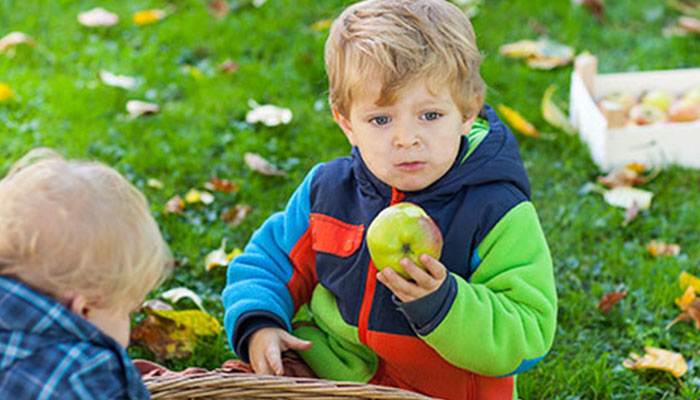While we believe that the books and resources recommended may be of value to you, keep in mind that these are suggestions only and you must do your own due diligence to determine whether the materials are appropriate and suitable for your use. PNC has no sponsorship or endorsement agreement with the authors or publishers of the materials listed.
FALL

Munchy, Crunchy Apples
Children will learn facts about apples.

Lesson Objective
Children will explore apples, including how they ripen in the fall, and learn about the parts of an apple tree.
ScienceArt
What You'll Need
- Red, green, and yellow apples (e.g., McIntosh, Red Delicious, Golden Delicious, Granny Smith, Rome Beauty, Honeycrisp, etc.) – 1 red, 1 green, and 1 yellow per every 8 children
- Wine corks – at least 1 per 2 children
- Paper towel tubes – one per child (Cut two 1” slits at one end of each tube. The slits should be at 12:00 and 6:00.)
- Glue or glue sticks
- Scissors
- Small paper plates – 2 per child
- Knife (to cut the apples)
- Red and green paint
- White construction paper – 1 sheet per child
- Picture of an apple tree
What To Do
- Display the picture of the apple tree and the apples. Cut open a red, a yellow, and a green apple and talk about the apples (see Did You Know and Guiding Student inquiry).
- Give each child a paper plate containing one slice each of a red, a yellow, and a green apple. Have the children taste and compare the apples (see Guiding Student Inquiry).
- Cut one apple treetop shape out of white construction paper for each student or trace the shape and have the children cut their own.
- Pour a small amount of green paint onto the remaining paper plates and give one to each child.
- Have the children use a finger or a thumb to make fingerprints all over the white treetop shape to represent the leaves.
- Add a small amount of red paint to the paper plates and have the children use the corks to stamp apples among the fingerprint leaves.
- Give one paper towel tube to each child. This is the trunk of the tree.
- When the painted treetops are dry, let the children slide their treetops into the slits in the tubes.
Resources
Home School Resources
Home educators: use these printable lesson PDFs to teach this lesson to your home schoolers. They're available in English and Spanish.
Content Provided By
Common Core State Standards Initiative – These lessons are aligned with the Common Core State Standards ("CCSS"). The CCSS provide a consistent, clear understanding of the concepts and skills children are expected to learn and guide teachers to provide their students with opportunities to gain these important skills and foundational knowledge [1]. Visit the CCSS


